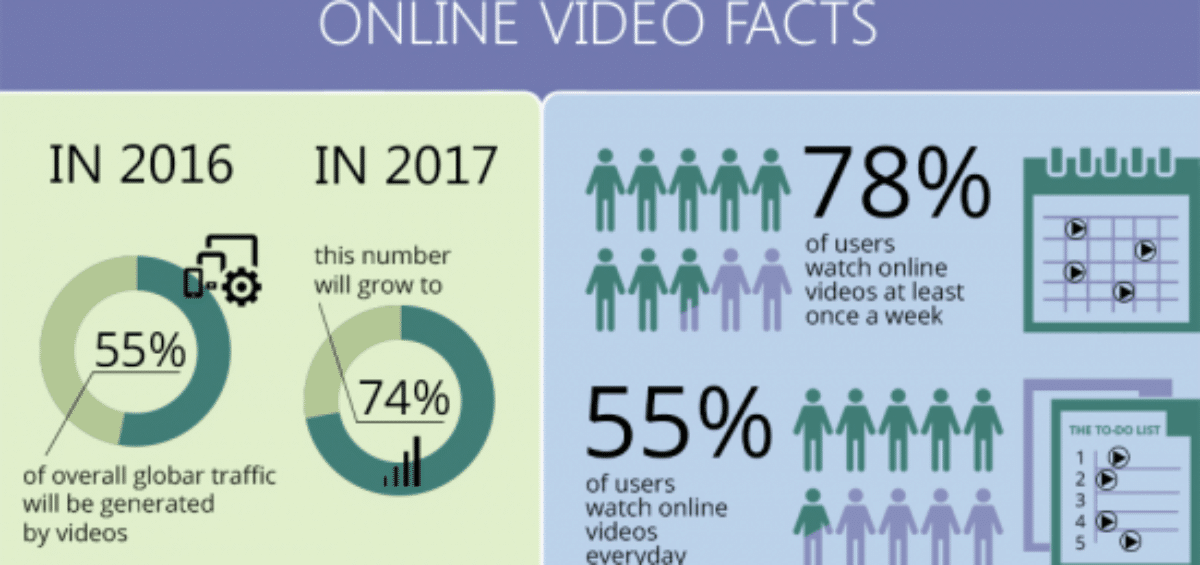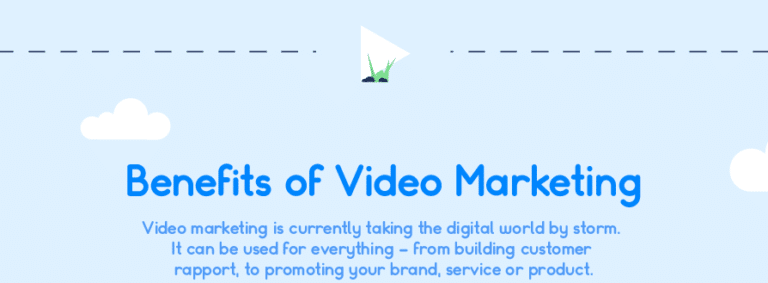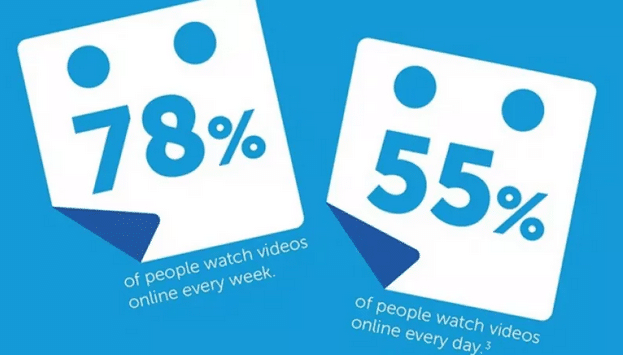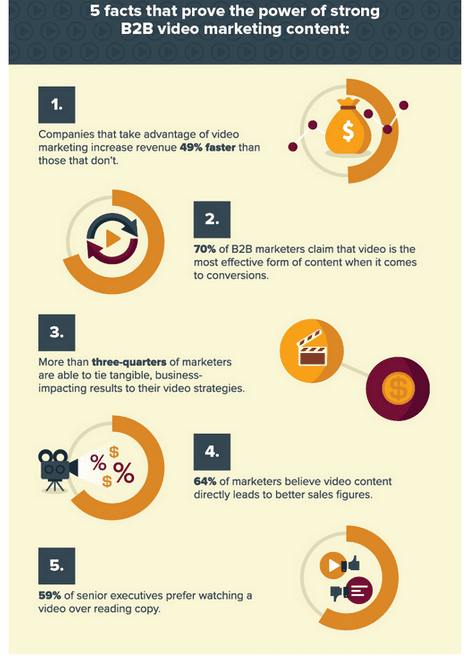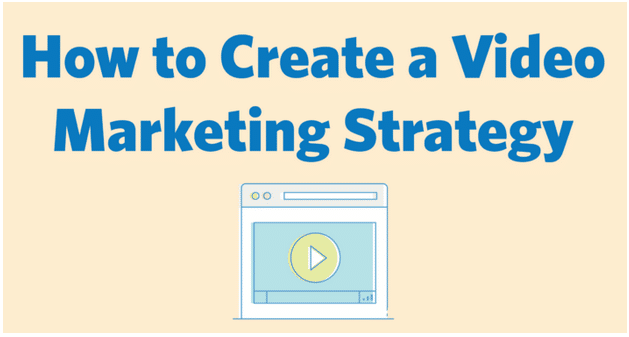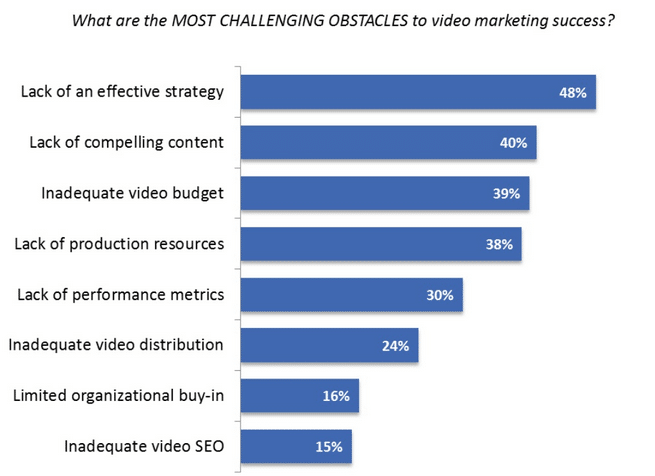Video marketing is one of the hottest trends in online marketing, and for a good reason. It serves many purposes on its own and as part of a more comprehensive marketing strategy. It is a highly effective method for increasing brand awareness, introducing new products, generating leads, and boosting sales. By taking a look at video marketing stats, you will start to see just how effective video marketing truly is. This is why we’ve included several video marketing stats throughout this post.
Videos, like whiteboard animations, provide many opportunities to connect and engage with audience. The more connections and engagement you achieve, the higher your conversion rates will be. And with more and more people using the internet, leveraging the crowd-pulling capability of video content is a great way to expand the success of your business.
A quick look at projected statistics for 2019 shows the tremendous potential of video marketing. A study conducted by HubSpot showed that more than 78% of internet users watched online videos every week. About 55% viewed videos online every day. According to current estimates, video traffic accounts for more than 80% of all internet traffic.
Clearly, video has become an integral part of the online experience. If you aren’t entirely convinced, there are many more video marketing stats below that indicate just how important video marketing is to current marketing efforts. If you haven’t yet begun to utilize the nearly limitless potential of video in your own marketing campaign, now is as good a time as any to get started.
Let’s take a closer look at video marketing stats and how you can use this form of marketing to connect with your audience, drive conversions, and grow revenue.
Video Marketing Defined
You’ve probably heard the phrase, “A picture is worth a thousand words.” Video marketing takes that concept and magnifies it thousands of times over. As effective as photos and graphic elements are, videos are even more powerful and have a lot more potential to attract and hold the attention of audiences.
Video marketing basically involves integrating video content into a bigger and more comprehensive marketing campaign. The percentage of video content versus other types of content can vary depending on the particular strategy you’re using. Some campaigns sprinkle video content into a blog post here and there, while others consist almost entirely of videos.
Video content can serve many purposes in a content marketing campaign. You can use them to enhance vendor-customer relationships, promote products, services or brands, or provide information and customer assistance. Videos work great for step-by-step how-to guides, product demos, highlighting answers on FAQs, and so much more. In some cases, video marketing simply aims to deliver entertaining content that has a good chance of going viral.
Benefits of Video Marketing
Video marketing provides many benefits for marketers as well as audiences. Whether your goal is to establish rapport with your customers, enhance your brand or business, or promote a new line of products or services, video marketing can help you with all of this. Here are some of the benefits of incorporating video into your marketing followed by some interesting video marketing stats.
Provides More Value to Your Customers
Most consumers prefer watching videos about products instead of reading about them. Videos make it easier to understand and retain information, especially technical details about gadgets and complicated machinery. Videos also let prospective buyers see the product in actual use, which helps them better understand its features and benefits and how it works.
When customers can better understand what a product is about, they are more likely to go through with the purchase. Even if you already promote your product via a blog or social media post, adding video content to these marketing platforms will increase your chances of making a sale.
How-to’s and product demonstration videos are especially useful for potential customers that are still on the fence. Providing video content that clearly communicates what a particular product does can help you convert window shoppers into actual paying customers.
Encourages Customers to Take Action
One of the primary goals of marketing is to encourage customers to take action. Whether the immediate goal is to close a sale, provide more information, or convince site visitors to sign up for a newsletter, marketing is about encouraging people along the path toward conversion.
Video marketing content is especially effective at encouraging site visitors to take action. For viewers who are still undecided about purchasing a product, a video can provide the final push that convinces them to make a decision.
You can enhance the value of your videos even more by optimizing them for conversion. This
involves creating videos that compel viewers to move along the conversion path by following directions and taking specific actions. By closing these videos with a strong and clear call to action, you can boost your leads and increase your sales.
Increases Brand Awareness
Video marketing is an especially powerful method for increasing brand awareness. There are many ways you can tailor your videos to boost your brand’s image and reach a broader audience.
You can share customer testimonials, answer relevant questions, and share compelling and engaging stories. With a carefully implemented video strategy, you can increase brand exposure considerably and expand your existing customer base.
Building brand awareness by way of providing video marketing content is an especially effective strategy given the immense popularity of YouTube. As the second-largest search engine in the world, YouTube provides you with an ideal platform for establishing a market presence, enhancing brand visibility, and reaching a wider audience.
Improves Audience Engagement
Live videos are especially useful tools for improving audience engagement. Given two videos on the same topic, most people will sit through the live video longer than they would the pre-recorded version.
This tendency is especially apparent on platforms such as Facebook, Instagram and Periscope, each of which has live streaming capabilities. On these and other social media sites, brand marketers can leverage their video content for maximum engagement.
One of the best things about live-streamed videos is that they engage viewers in real-time. This is a crucial factor in building knowledge, trust and confidence in a company.
Live streaming videos can take on many forms and have different focuses. You can host a live Q&A session, for instance, or report a new development in your niche. Behind the scenes at industry events are always popular, as are chats with experts or recognized authorities. Whatever approach you take, live streaming videos gives your viewers the sense of being in the loop, which in turn makes them feel a connection to your brand.
Communicates Your Brand’s Personality and Culture
Videos can introduce your brand’s culture to your customers and immerse them in the experience. When looking for a way to show off your brand’s personality and passion, few methods are as effective as video marketing. Videos give your brand a human face and make your customers feel that they can relate to the company.
The success of a company often depends on an image of authenticity and transparency. Well presented video content can inspire these perceptions in customers, helping contribute to a trusting relationship.
Establishes Your Brand as an Authority
Video marketing helps establish you as an authority in your niche, which makes people have more trust in your brand. You can achieve these goals by providing content that solves problems and focuses on educating others about subjects related to your area of expertise.
Video content that inspires your audience can work in your favor, as well. Getting your audience to draw inspiration from your content will help establish you as a thought leader and boost your brand’s image as an industry authority.
Video marketing gives you an ideal opportunity to showcase your expertise. By providing your audience with useful and relevant information and addressing their concerns, you can quickly build up your brand’s credibility within your niche.
Video Marketing Stats
For a truly thorough understanding of how well video marketing works, it’s important to take a look at some of today’s more prominent video marketing stats. Each video marketing stat below will help you understand why video marketing should be a central focus of your brand’s marketing campaigns.
Most people know YouTube as a video streaming site, but it is also the second biggest social media network on the internet, eclipsed only by Google. More than a billion people watch videos on YouTube, which accounts for a third of all internet users. Altogether, the site logs more than 500 million hours of video views from all over the world every day.
Facebook is another hugely popular social media platform that accounts for a healthy portion of video traffic. According to Forbes, more than 500 million people watch Facebook videos every day. It is estimated that 45% of internet users watch more than an hour of videos on Facebook and YouTube.
Even Twitter commands a healthy share of online video traffic. More than 82% of the site’s users regularly watch videos on the social media platform.
To get an idea of just how much video is part of the online experience, consider this: more videos are uploaded within 30 days than the combined total of program material produced by all major television networks in the United States in the past 30 years.
The country with the highest rates of online video access is Saudi Arabia. Every day, around 98% of the country’s population accesses some form of online video. The United States also accounts for a good share of online video traffic. Of all internet users in the country, more than 85% watch videos online.
Out of all the age groups, millennials account for the most number of online viewing instances. Men also tend to spend 40% more time viewing videos than women.
If you are looking to boost your engagement numbers via video marketing, you should know that video content can increase revenue growth by as much as 49%. This is because more than 64% of consumers are encouraged to purchase a product after viewing brand videos on the internet. Furthermore, given a choice between video and text content, most consumers will opt for video.
Drawbacks of Not Implementing Video Marketing
By looking at video marketing stats and the benefits of video marketing, it becomes apparent just how vital a properly implemented video marketing strategy is to any brand. What isn’t as obvious is that neglecting to utilize video in your marketing could have significant drawbacks. Without the power of video, your site’s SEO ranking may stagnate. This is mainly because you lose the ability to use video thumbnails on your website.
By not having videos on your web pages, you also miss many opportunities to connect with your audience via an engaging and compelling format. This could cause your conversion rates to remain fixed to the industry average, with little chance of registering an upward increase.
The absence of video content on your site will also make it more difficult for you to catch the attention of decision-makers in your niche. This, in turn, hinders your growth. Additionally, it puts you out of the running for valuable opportunities for development and expansion.
All these factors and more can have long-term adverse effects on your brand and business. All brands should consider video marketing stats, the many benefits of video marketing, and the possible drawbacks of neglecting to implement it. After a thorough assessment, you see that there are very few valid reasons why you shouldn’t utilize video as an essential component in your marketing.
Potential Revenue from Video Marketing
As with most forms of marketing, the bottom line with video marketing is just that: the bottom line. The amount of revenue generated often determines the success or failure of a marketing campaign. For most brands, the most popular question is, “How much money can I actually make by focusing on video marketing?”
It is especially important to figure out how much revenue you can generate via video marketing, considering the cost of creating videos. Compared to other types of content, videos are more expensive and take a lot more time to produce. This is why you should figure out whether focusing your time, effort and resources on video marketing will be worth it.
The good news is that video marketing does have massive potential for generating a healthy revenue stream. If it is implemented correctly, video marketing can result in a significantly higher ROI than almost any other type of content you can create.
So how much revenue can you actually generate via a video marketing strategy? The figures will vary depending on the campaign. However, many video marketing statistics suggest that video content often goes a long way in encouraging site visitors along the path toward eventual conversion.
In a study conducted by HubSpot, video marketing stats revealed that videos embedded in a landing page can boost conversion rates by at least 80%. These video marketing stats also revealed that mobile users are more likely to share video content because it is easy to share videos via mobile devices.
Furthermore, consumers are more likely to purchase a product after viewing a video about it. More than 80% of video audiences actually remember the specific points of a video up to 30 days after initially seeing it.
All these video marketing stats suggest that video content is a huge contributing factor in encouraging viewers to purchase a product. By helping move viewers along the conversion funnel – and even inspiring viewers to take a specific action – video marketing becomes a powerful revenue-generating strategy.
Video marketing can be even more effective if you develop video content that is aligned with your marketing goals. By tailoring your videos to increase conversion rates or influence customers, you gain a better appreciation for how video marketing can help increase revenues.
Video Marketing How-To
Apart from the technicalities of producing the video, video marketing is pretty much like most other forms of marketing. Launching a video marketing campaign is relatively simple. You simply create videos according to your goals, whether they are to promote your business, drive sales, introduce your products or services, or engage customers.
But ensuring the success of your campaign can be a bit more challenging. As with all marketing campaigns, you will have to monitor metrics and take note of customer engagement. This is especially crucial given the data-driven nature of video marketing.
Video marketing strategy can be broken down into a few key steps:
Resource allocation. Allocating your resources properly is essential to the success of your video marketing campaign. You will have to outline a budget for video production, which should cover video equipment, editing software, and the personnel to create the video. You should probably put together a dedicated video marketing team to oversee the campaign as well. You can use the pre-production video marketing checklist to help you with allocating resources.
Storytelling. Telling a story is an important part of any marketing campaign, and it is especially crucial with video marketing. Think about what stories you want to say and how you will share them with your audience. Presenting interesting stories in a compelling manner through video will increase your chances of holding your viewers’ attention.
Customer engagement. Go beyond simply telling stories and strive to engage your customers. Having a hook to go along with your story is an especially effective strategy. This hook could be anything from a historical backgrounder to unique or interesting details about your company or product, or real world scenarios that prove the value of your brand. Just the same as video marketing stats help brands see why video marketing is so important, you can even use stats relating to your own product to increase conversions.
Trimming down. Shorter videos tend to be more effective than longer ones. Unless you are covering a complex topic or a lengthy procedure, it is best to err on the side of brevity. Even if you need to cover a particular topic in-depth, it is generally a good idea to break it up into easily digestible segments.
When producing video content, it’s hard to resist the temptation to pack it full of details, which often results in a longer runtime than necessary. Try to focus on a few key concepts and cut out any extra fat. Keep your videos informative, but short and straight to the point, and they will be more likely to hold your viewers’ interest.
Publication. Publishing the videos that you have worked so hard to produce is another essential step in the video marketing process. For maximum exposure and ROI, try to get your videos out on as many channels as possible: your website, on YouTube, Instagram, and other video streaming sites, and all your social media channels. And as with any other type of content, promote your videos at every opportunity.
Analysis. Your work doesn’t end with the publication of your videos. You have to keep a close watch on your video marketing stats and metrics to find out which videos are performing well and which don’t deliver the expected results. A thorough analysis of your videos’ performance will also help you figure out how you can modify and refine your video marketing strategy for better results.
Video Marketing Challenges
Video marketing isn’t always a walk in the park. Just as with any marketing campaign, you will come up against some challenges.
The good news is that the advent of affordable equipment has largely eliminated many of the challenges associated with producing videos. Even pro-level cameras and editing equipment are cheaper and more accessible than ever. Nowadays, you can come up with impressive-looking videos even with a fairly modest budget.
Even from the viewer’s vantage point, accessing video content is easier than ever. With high-speed internet and more affordable computer equipment and mobile devices, almost anyone can access the video content you provide.
Of course, you still have to spend money on equipment, software and video streaming platforms – the best of these aren’t free, after all. And you still have to put together a marketing team that can produce quality videos.
But the real challenge in mounting a video marketing campaign has to do with strategy. Knowing how to create content that engages viewers and compels them to share is one of the biggest challenges you have to face.
You will also have to track and analyze performance via certain crucial metrics. You can do this with data dashboards. Overcoming these and other obstacles will help you develop an effective video marketing campaign and fine-tune its performance to work to your benefit.
Conclusion
Perhaps the most important lesson you can take away from all this is that data and strategy should drive your video marketing efforts. You can maximize the results you will get from your campaign by developing a strategy that accounts for every stage of the sales funnel. You should also tailor each video to help you achieve specific goals.
Finally, know what metrics are relevant to the success of your videos. Make sure to track and measure the video marketing results, and don’t be afraid to tweak your methods or start over if necessary. You can get better as you go along, and your video marketing will provide better results over time.
Are you ready to integrate a robust video marketing strategy into your overall marketing ecosystem? If so, contact IGW today. We can share some more interesting video marketing stats with you as well as help you create video content that resonates with your audience and drives conversions.

